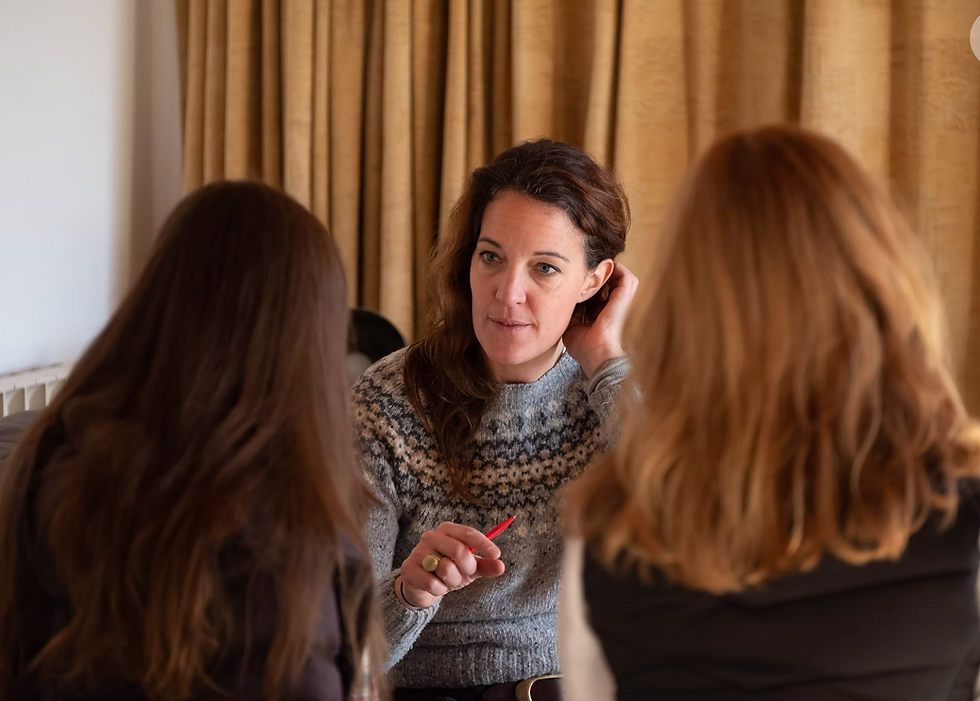What happens in an Equine Therapy session?
- Nina Leijerstam
- Oct 13
- 3 min read
Step into a different pace - where words are optional, and your whole self is welcome.
Equine therapy sessions at Track Clinic are gentle, immersive, and uniquely tailored to you. Each session is guided by two facilitators and shaped around your needs, your pace, and the responses of our free-roaming herd.

BEFORE YOUR SESSION
Before your first session, you’ll have a short phone call with your facilitator to talk through what’s happening for you (or your child) right now, your hopes for the sessions, and any practical or emotional considerations.
If your child is attending, you’ll be supported in how to talk with them about the sessions in a way that helps them feel safe and at ease — so they can arrive curious, not pressured or worried.
This time is for you both to gather your thoughts and feel supported as you get ready to step into the space with the horses.

DURING YOUR SESSION
When you arrive at Track Clinic, you’ll be welcomed and shown around so you can settle in.
You’ll then be introduced to the herd in a way that feels comfortable for you. This might mean:
Meeting them one by one
Staying separated by a fence for a sense of safety
Or allowing them to make the first move, choosing if and when they approach
Sometimes the herd are very still and quiet throughout a session. At other times, there may be lots of movement and interaction.
You are free to be alongside them or observe from a short distance. You might walk, sit quietly, or even lie down and rest in the hammock or shepherd’s hut with the herd just outside the door.
The session itself lasts around 60 minutes and is co-facilitated by a licensed mental health professional and a trained equine specialist. As you spend time with the herd, the facilitators observe the subtle interactions between you and the horses — noticing shifts in posture, breathing, movement and energy that may signal changes in your emotional state.
They will support you to stay in a place of curiosity, allowing the herd to mirror and respond to you. If a particular pattern of behaviour becomes clear, you may be gently invited to consider how things could be different and to experiment with new ways of relating.
Sometimes, the session may be framed around a theme that matters to you — giving you space to explore it more deeply, gain new insight, and reflect on how it connects to your relationships, home or work life.
You can choose how verbal or non-verbal you want to be. Sometimes no words are needed at all, or only a few.
When working with children (as young as six years old), they don’t need to analyse or explain their situation. Instead, they are supported to find what they need, relate in a way that feels right, and respond authentically to what the horses are showing.
Changes often happen subconsciously — sometimes very noticeably after just the first couple of sessions. Parents often share that their child has become more relaxed, more willing to communicate, and that the relationship dynamic at home has softened or even changed completely. They may also see their child becoming more open to new experiences and able to name what they need.
After your first session, you will have a 20-minute follow-up call to reflect on what emerged and how you are feeling.If you go on to do a block of therapy (either six weekly sessions or an intensive two-week programme), you’ll also receive a written report summarising the therapeutic process and changes observed.

AFTER YOUR SESSION
People often describe feeling more centred and regulated after a session, yet also tired as their body integrates the experience.
Other common responses include feeling:
Lighter, clearer or more grounded about their situation
Changed in some way, with a more positive outlook
Opened, intrigued or surprised by what came up
Able to communicate needs more clearly
More able to speak their truth
WHY IT WORKS
The power of equine therapy lies in what naturally emerges in real-time between you and the herd. As you spend time together, you may notice emotions surfacing, patterns in how you relate becoming clearer, and subtle shifts in your body and energy.
The horses often mirror your emotional state and deeper needs, offering a kind of honest, non-verbal feedback that is hard to access through words alone. They frequently act as living metaphors for what is happening in your life, revealing dynamics that might otherwise stay hidden.
With sensitive guidance from the facilitators, these moments become opportunities to explore, experiment and try new ways of being. This process is part of a structured therapeutic model that is evidenced to bring about long-lasting emotional and behavioural change, helping people develop deeper self-awareness, emotional regulation and healthier relationships.



